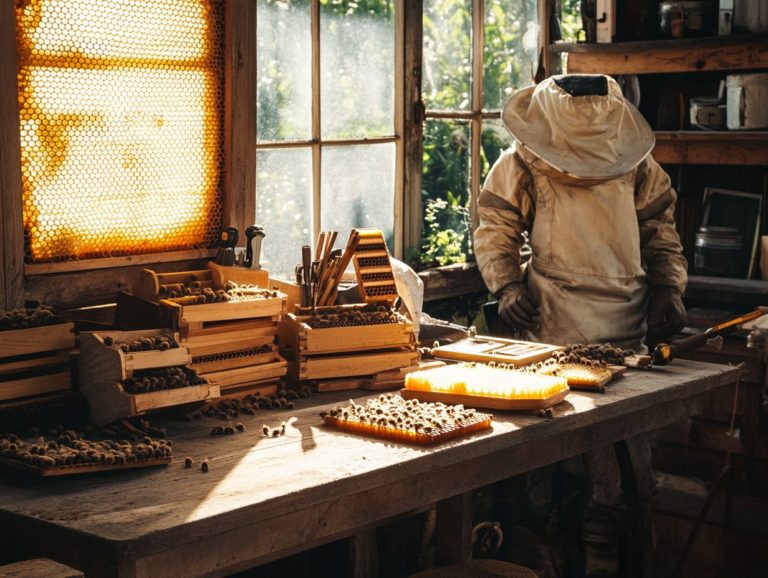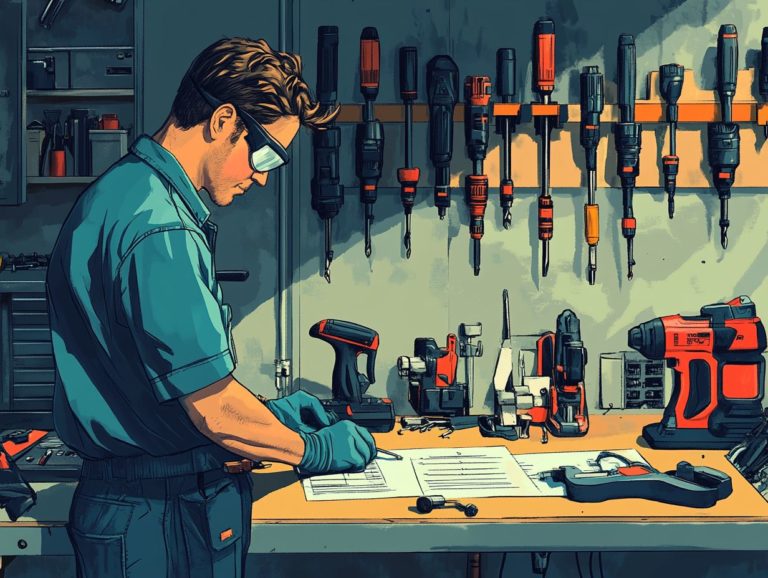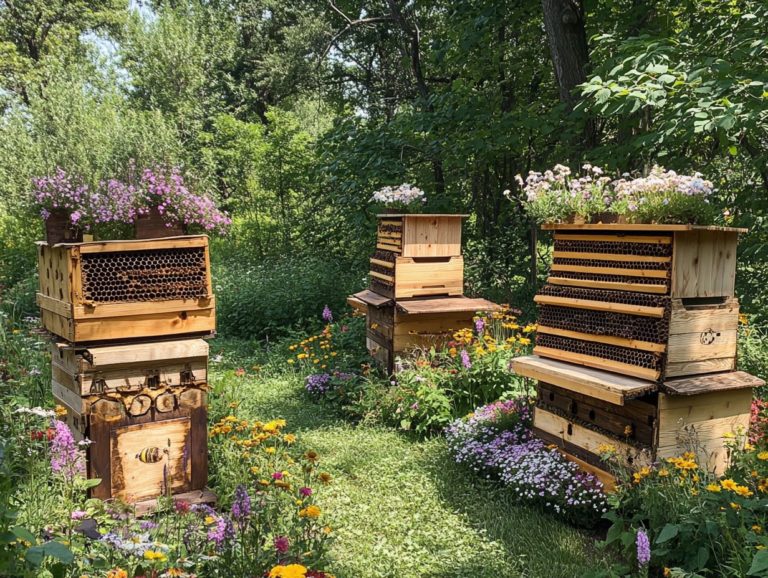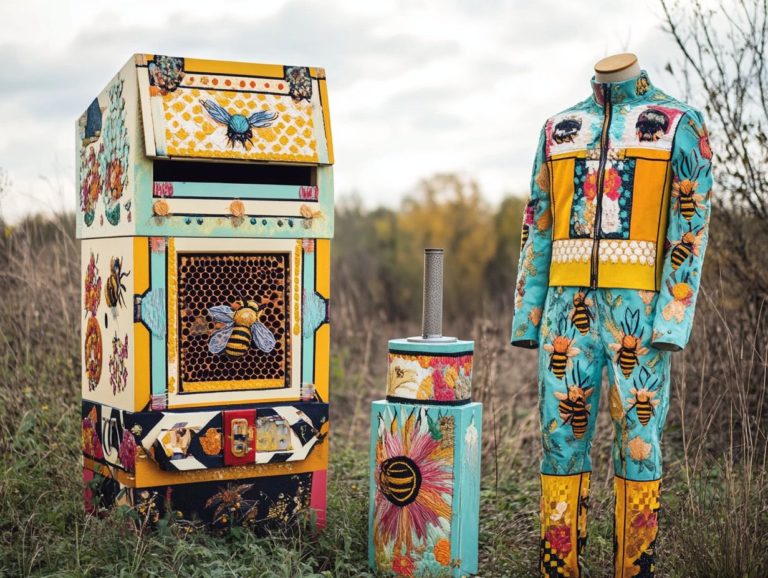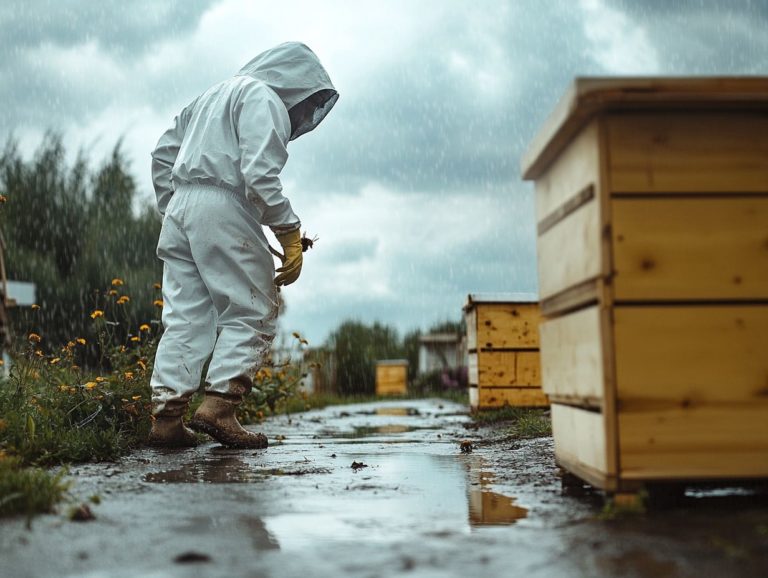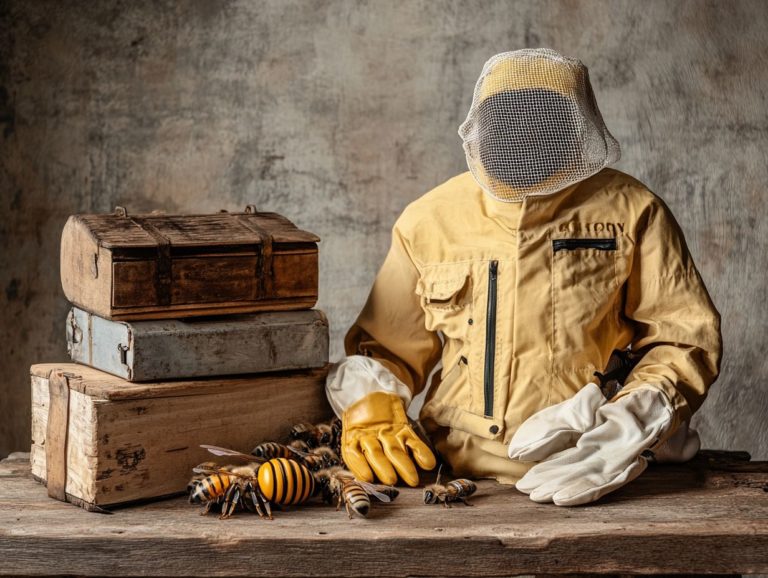Top 5 Beekeeping Equipment for Beginners
Beekeeping transcends the realm of mere hobby; it stands as a critical practice that sustains our ecosystems and bolsters our food supply. Join the buzzing world of beekeeping today! Discover the must-have equipment and start your adventure now!
As a beginner ready to embark on this enriching journey of beekeeping, grasping the essential beekeeping equipment is paramount.
This article outlines the top five indispensable items for beginner beekeepers, ranging from protective suits to honey extractors.
Whether you re intrigued by how a smoker can soothe bees or curious about the tools that simplify hive management, including beekeeping gloves and honey bee feeders, you ll discover everything necessary to set forth on your beekeeping adventure.
Contents
- Key Takeaways:
- 1. Beekeeping Suit
- 2. Smoker
- 3. Hive Tool
- 4. Bee Brush
- 5. Honey Extractor
- What Is Beekeeping and Why Is It Important?
- What Are the Basic Equipment Needed for Beekeeping?
- How Can a Beginner Choose the Right Equipment?
- What Are the Different Types of Beekeeping Suits?
- How Does a Smoker Help in Beekeeping?
- What Are the Different Types of Hive Tools and Their Uses?
- How Does a Bee Brush Benefit Beekeepers?
- What Are the Different Types of Honey Extractors and Their Features?
- Frequently Asked Questions
- 1. What are the top 5 beekeeping equipment recommended for beginners?
- 2. Why is a hive considered the most important equipment for beekeeping?
- 3. Do I need to wear protective gear while beekeeping?
- 4. How does a hive smoker help in beekeeping?
- 5. What is the purpose of a hive tool and other beekeeping tools in beekeeping?
- 6. Can a beginner start beekeeping without any beekeeping equipment?
Key Takeaways:
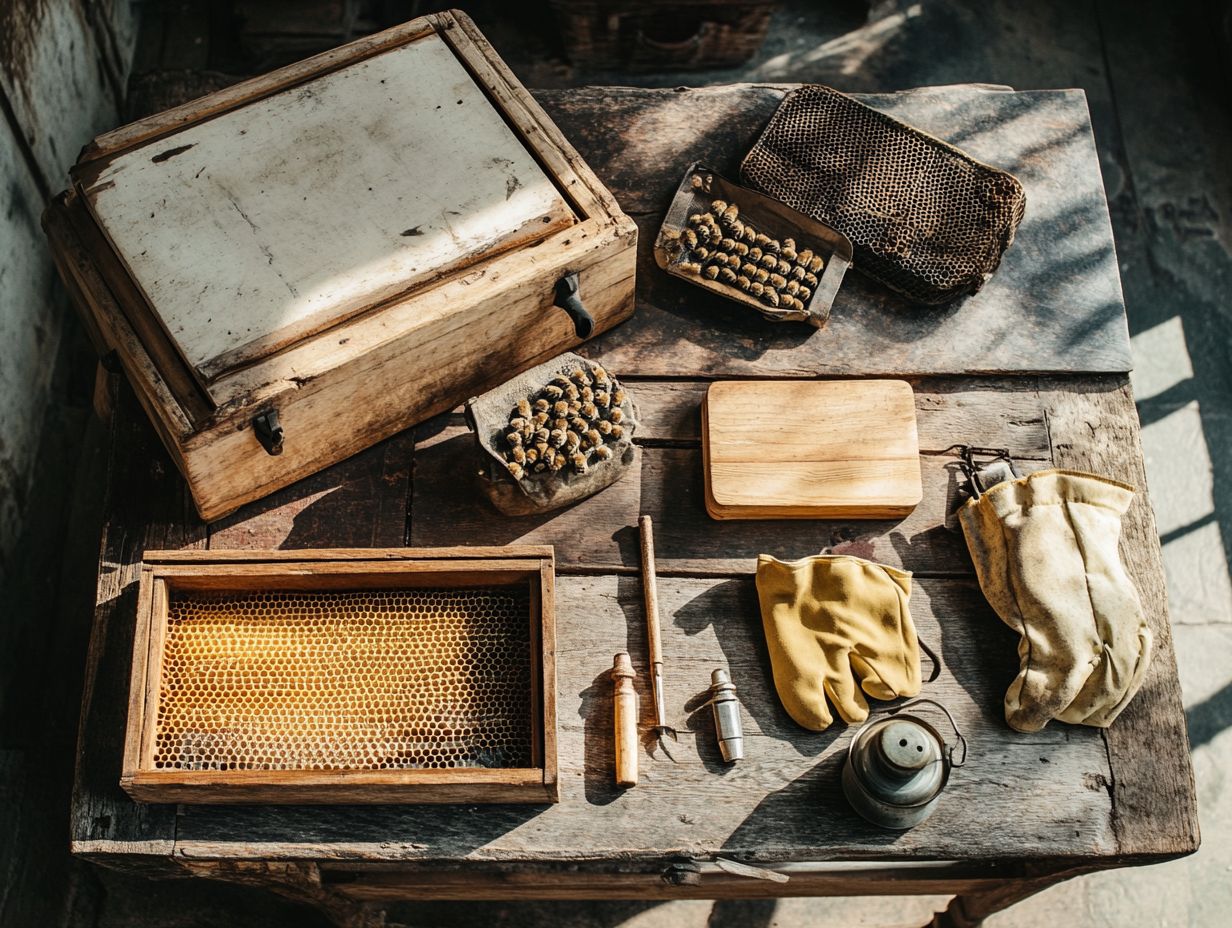
- A beekeeping suit is essential for protecting yourself from bee stings and should be made of lightweight, breathable material.
- A smoker is used to calm bees and make them less likely to sting and should be made of stainless steel or galvanized metal for durability.
- A hive tool is necessary for inspecting and manipulating hives and can come in different shapes and sizes depending on your specific needs. It is an essential beekeeping tool for both beginners and seasoned beekeepers.
1. Beekeeping Suit
Beekeeping clothing, like a beekeeping suit, is essential for protecting you from stings. This protective gear ensures your safety and comfort during hive maintenance.
Beyond personal safety, these suits help maintain bee health. They reduce stress responses triggered by sudden movements or perceived threats.
Beekeeping suits, a part of essential beekeeping clothing, come in various styles, from full-body jumpsuits to ventilated options and lightweight designs perfect for warmer weather.
Different materials like cotton, polyester, and specialized mesh offer varying levels of protection and breathability, making it essential to select a suit that fits well and allows you to move with ease. Proper sizing is key to achieving complete coverage and comfort during those long hours in the apiary.
As a beginner, seeking advice from local beekeeping clubs or trusted online platforms, such as Amazon, can be invaluable in finding the right suit for your needs. These resources not only provide quality supplies but also community recommendations, helping you secure the best options tailored specifically for your beekeeping journey.
2. Smoker
A smoker is an important tool in your beekeeping arsenal, playing an important role during hive inspections by calming honey bees and minimizing aggressive behavior. This facilitates safer and more efficient management of your bee colonies. Mastering the proper use of a smoker is essential for maintaining bee health and ensuring effective care and organization of your beehives.
Smokers operate by generating cool smoke that masks the chemical signals released by bees when they feel threatened, effectively diminishing their inclination to swarm or exhibit defensiveness. This creates a more tranquil atmosphere for both you and the bees, allowing for thorough inspections and smoother honey harvesting.
When selecting a reliable hive smoker, consider key factors such as durability, size, and heat retention capabilities. Renowned brands like Mann Lake and Kelley Beekeeping provide quality options that are readily available at local beekeeping supply stores or online.
Proper maintenance of your smoker involves regular cleaning to prevent residue buildup. Using the right fuel, such as pine needles or burlap, enhances smoke production. Incorporating these beekeeping techniques ensures effective hive management.
3. Hive Tool
A hive tool is an essential instrument for beekeepers. It tackles tasks such as prying apart hive components and scraping away excess propolis. This tool is crucial for hive maintenance. When you utilize a hive tool correctly, you can significantly boost your efficiency in managing bee colonies, ultimately leading to successful honey production.
You’ll find several types of hive tools available, each designed for specific tasks. For instance, a flat hive tool helps lift frames, while a forked tool is great for scraping and cleaning. These tools not only streamline hive inspections but also help prevent injuries to the bees during routine maintenance.
As a beginner, it’s wise to choose durable materials that can withstand the rigors of beekeeping. Practicing proper handling techniques will help minimize disturbances within the hive, ensuring smooth honey harvesting and hive maintenance.
Quality hive tools can be sourced from local beekeeping supply stores, gardening centers, or online retailers specializing in beekeeping gear. This ensures you have everything you need in your beekeeping toolbox to maintain your hives effectively.
4. Bee Brush
A bee brush is your go-to tool in beekeeping, designed specifically to gently coax bees away from frames during hive inspections or honey harvesting. This approach minimizes harm to the bees while allowing you to effectively manage the colony. Mastering the correct technique for using a bee brush is crucial for maintaining bee health and ensuring a successful honey yield.
With its soft bristles, a bee brush enables you to gently brush bees aside without squashing or stressing them an essential practice during hive inspections when you’re evaluating colony health or retrieving honeycombs. This gentle touch helps maintain the delicate balance within the hive, fostering a thriving environment for your bees.
As a beginner, it’s wise to practice calm, deliberate movements. Keep the brush parallel to the frames, applying a light touch and avoiding any sudden gestures that might rattle the bees. You can find quality beekeeping supplies, including bee brushes, at local apiaries, specialty gardening stores, or online retailers that cater to beekeeping enthusiasts.
Choosing the right tools is key; it enhances your beekeeping experience and lays the groundwork for sustainable beekeeping and honey production practices.
5. Honey Extractor
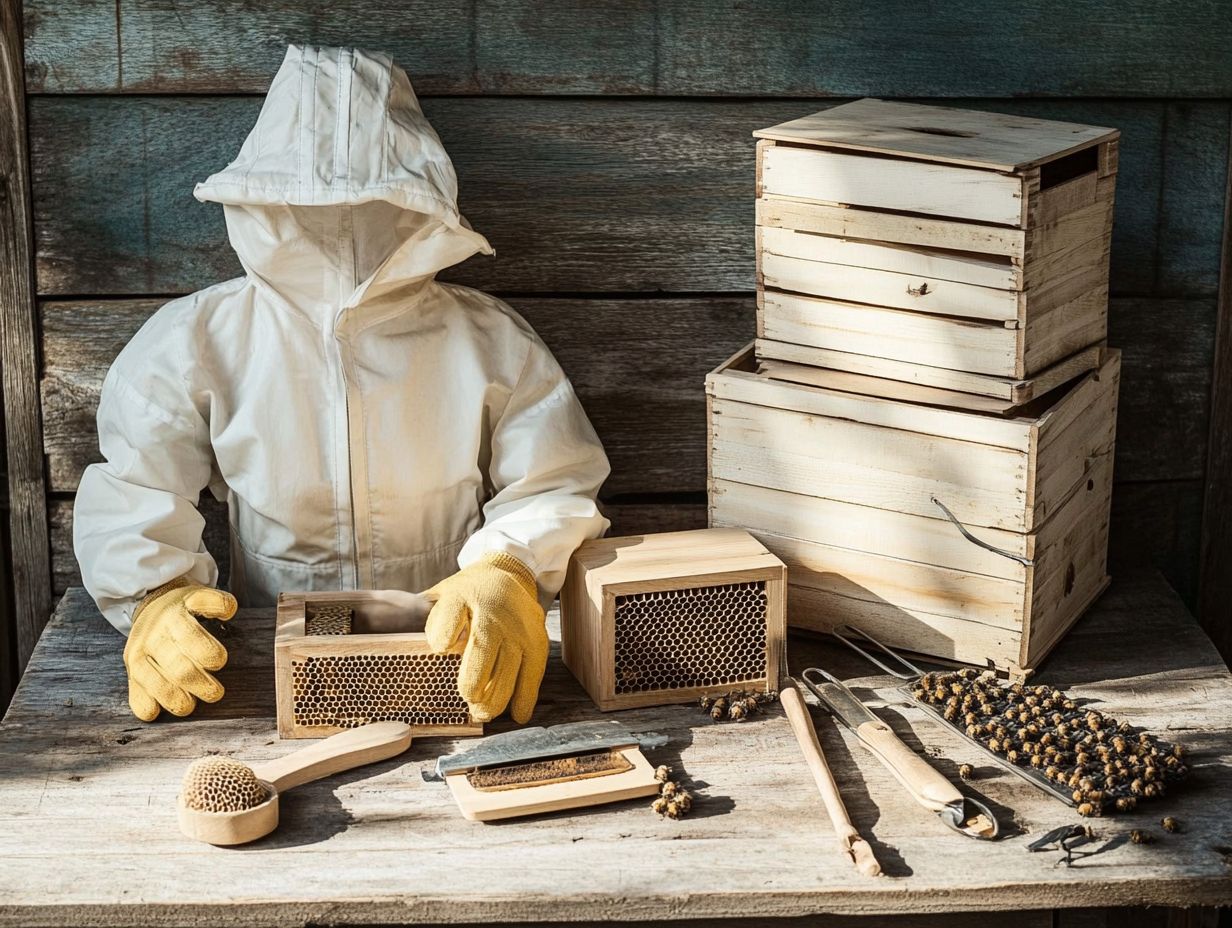
A honey extractor is an essential tool in your beekeeping arsenal, designed to extract honey from the honeycomb without causing any damage to the comb. With it, you can quickly and safely collect honey while promoting sustainable practices in your apiary. When used correctly, a honey extractor not only guarantees high-quality honey production but also preserves the integrity of your beehive, setting the stage for future harvests.
You’ll find a variety of honey extractors on the market, each boasting unique features tailored to different scales of operation. If you re a hobbyist with just a handful of Langstroth hives, a manual extractor might be your perfect match. On the other hand, if you re diving into larger-scale beekeeping, an electric model can significantly expedite the extraction process.
As a beginner, it s vital to consider your harvesting needs, the number of hives you maintain, and the space you have available when selecting an extractor. Plus, weighing your options, don t overlook the importance of proper maintenance and care regular cleaning and hive inspections for wear and tear are crucial for ensuring the longevity of your equipment.
Brands like ManLake and Dadant are known for their reliable extractors, and you can easily find beekeeping supplies at local farm stores or specialty online retailers. Choosing the right honey extractor is vital for quick harvests don t wait to upgrade your tools! With the right equipment and a bit of knowledge, you can savor the sweet rewards of beekeeping.
What Is Beekeeping and Why Is It Important?
Beekeeping involves various supplies and techniques, making it a comprehensive activity that requires proper knowledge and tools.
Beekeeping is a thrilling adventure that allows you to nurture bee colonies while helping our environment! It s the art of managing honey bees to produce not just honey but also valuable products like beeswax and propolis. It s also a contribution to the health of our ecosystem through essential pollination, the process that helps plants reproduce. Sustainable beekeeping practices are integral to maintaining this delicate balance.
Engaging in this vital practice supports sustainable agriculture and enhances backyard gardens. It also deepens your understanding of bee species and their fascinating behaviors. Beekeeping classes and groups can expand your knowledge further. By participating in beekeeping, you play a pivotal role in ensuring the survival of these crucial pollinators within our environment. Act now to support these crucial pollinators!
Beekeeping boosts biodiversity and fosters ecosystem health by facilitating the reproduction of flowering plants that countless other species rely on for their survival. For local agriculture, bees directly influence crop yields as they pollinate a substantial portion of the food you consume yes, that includes the fruits, vegetables, nuts, and seeds that fill your plate. Backyard beekeeping can be particularly beneficial in this regard.
Embracing backyard beekeeping offers you a rewarding chance to connect with nature, harvest your own honey, and cultivate a vibrant garden that benefits both yourself and the environment. By adopting sustainable beekeeping practices, you promote the health of bee colonies, minimize the use of harmful chemicals, and encourage biodiversity, ultimately contributing to a healthier agricultural landscape for all. Beekeeping starter kits are a great way to begin this journey.
What Are the Basic Equipment Needed for Beekeeping?
Some essential beekeeping equipment includes a beekeeping suit, hive tool, smoker, honey extractor, and bee brush. These items are crucial for both novice and experienced beekeepers to maintain healthy and productive hives.
To embark on your beekeeping journey with confidence, it’s essential to familiarize yourself with the basic equipment required. This includes key tools like a hive tool, essential supplies such as a Langstroth hive (a common type of beehive used by beekeepers), beehive frames, and a smoker. Knowing about the top 5 must-have items for beekeepers elevates your beekeeping experience and plays a vital role in ensuring the health and productivity of your bee colonies.
Each of these tools serves specific functions crucial for managing and maintaining thriving hives. For example, the hive tool is your best friend when prying apart frames and scraping away unwanted debris, while the smoker is critical for soothing your bees during inspections.
Selecting high-quality supplies is equally important; buying strong and reliable hives and frames can significantly enhance their longevity and improve your honey yields. As a beginner, prioritize durability, ease of use, and safety features when choosing these tools. This thoughtful approach will not only make the process enjoyable but will also effectively support your bees needs.
How Can a Beginner Choose the Right Equipment?
Choosing the right equipment is essential for your success as a new beekeeper; it can significantly impact both your success and enjoyment while managing a bee colony. Opting for beginner beekeeping starter kits that include essential tools and equipment can simplify the process, making it easier for you to dive into hive maintenance and honey production.
Take a moment to evaluate your individual needs based on factors like climate, local flora, and the space you have available for hives. This will help you determine what specific equipment you require. For example, if you re in a cooler climate, you might need insulation for your hives, whereas if you live in a region with abundant nectar, you could potentially expand to larger hive setups.
You should also consider whether to invest in a starter kit or to purchase items separately. Typically, starter kits offer better value and include the essential components you ll need to get started. As you shop for supplies, be sure to seek out quality materials that guarantee longevity and safety for the bees, such as sturdy hive boxes, stainless steel tools, and protective gear that fits you comfortably.
What Are the Different Types of Beekeeping Suits?
In terms of beekeeping suits, you ll find a variety of options, each tailored to offer different levels of protection and comfort during hive inspections and honey harvesting. Understanding these distinctions is vital for ensuring your safety and effectiveness in managing your bee colonies.
The primary styles you might consider include full suits, which provide comprehensive coverage with elastic cuffs and a high collar to shield you from stings. Jackets are perfect for warm weather or quick checks on your hives if you prefer a more flexible choice. For those working in hotter climates, ventilated suits featuring mesh panels are an excellent option, allowing for breathability while you work.
When selecting your ideal beekeeping suit, think carefully about the fit to ensure there s enough room for movement. The material is equally important; lightweight fabrics can significantly enhance your comfort without compromising on protection. Always choose suits that adhere to safety standards, while also reflecting your personal style and functional needs.
How Does a Smoker Help in Beekeeping?
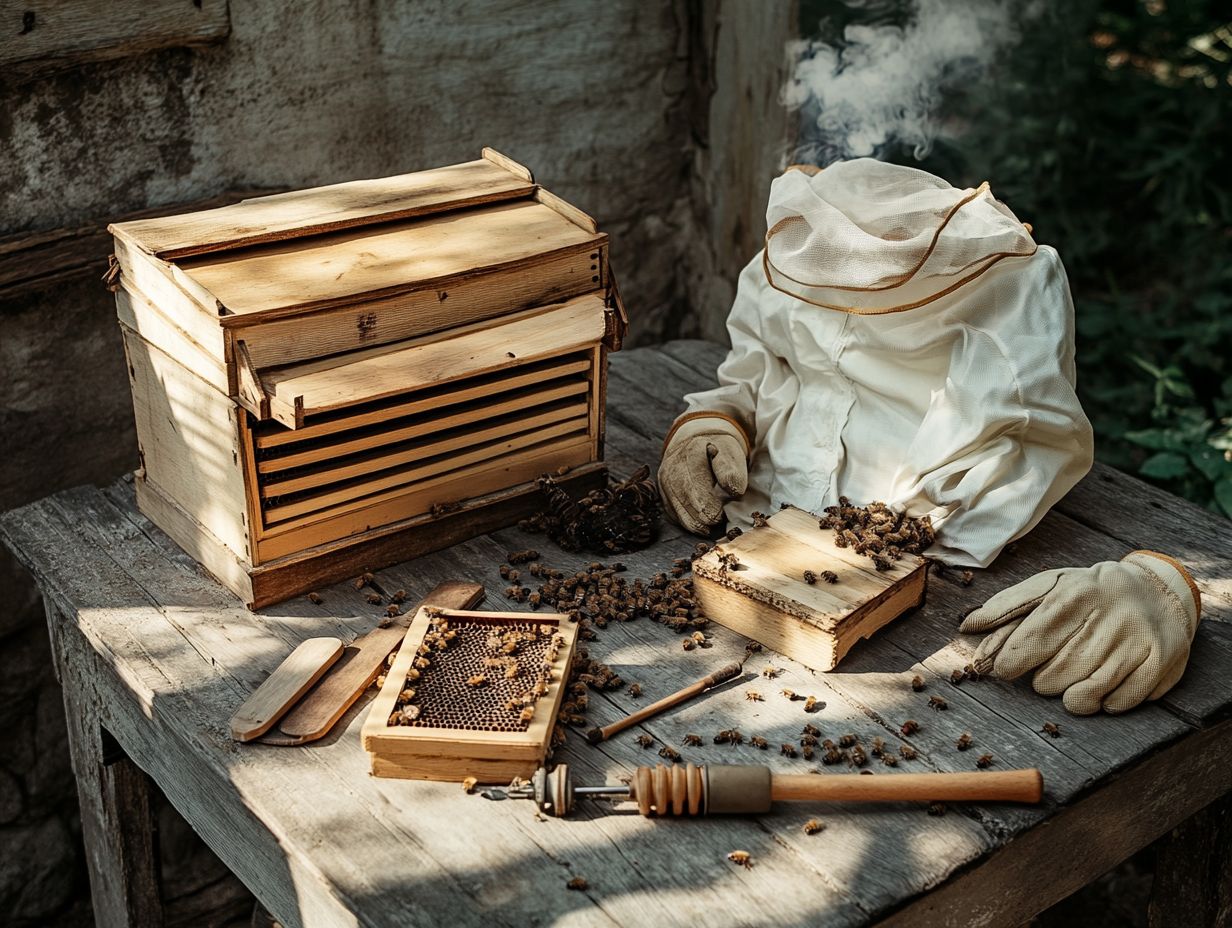
A smoker is an essential tool in your beekeeping arsenal. It helps you manage honey bee behavior safely during hive inspections by creating a calming effect. The smoker prevents bees from becoming aggressive, ensuring not only your safety but also the well-being of the bee colony during routine maintenance.
The mechanics of a smoker are quite straightforward. It operates by burning organic materials like wood chips or herbs, which generate smoke that masks the chemicals that bees release to signal danger. This disruption in their chemical communication can significantly reduce defensive behaviors, fostering a more serene atmosphere within the hive.
Light your smoker well before your inspection to ensure a smooth process! You should ensure that there s a steady airflow and consistent smoke production. Prioritizing safety is crucial; keeping a container of water nearby is wise for extinguishing the smoker after use and preventing any flare-ups.
This approach cultivates a peaceful environment for both you and the bees. It enhances your overall hive management, leading to a more productive beekeeping experience. You can then focus on your passion without unnecessary stress.
What Are the Different Types of Hive Tools and Their Uses?
There are various types of hive tools, each tailored for specific functions that are essential for your beekeeping tasks, whether it s hive maintenance, honey harvesting, or managing your bee colonies. Getting acquainted with these vital tools can significantly boost your efficiency and effectiveness in overseeing your hives.
Among these essential tools, here are some that are particularly critical:
- The hive tool: perfect for prying apart frames with ease.
- The bee brush: designed to gently remove bees from surfaces without causing distress.
- The smoker: a trusty companion that calms your bees during inspections.
Selecting the right tools hinges on your level of experience and the specific tasks at hand. As a novice, you might find a basic hive tool set to be quite beneficial, while seasoned apiarists may seek specialized instruments to handle more advanced colony management challenges.
Regular maintenance of these tools is essential. Clean your tools after each use to keep them in top shape! Proper care includes cleaning, sharpening edges, and checking for any signs of wear or damage, all of which contribute to the longevity and reliability of your equipment.
Now that you understand these tools, gather your equipment and get started with confidence!
How Does a Bee Brush Benefit Beekeepers?
A bee brush is a critical tool that offers remarkable advantages for you as a beekeeper. It enables you to carefully move bees from frames during hive inspections or honey harvesting, all while ensuring the bees remain unharmed. This gentle method is essential for happy bees and for streamlining your workflow.
In contrast to other methods like smoke or mechanical tools which can unsettle the bees and heighten their stress or aggression, the bee brush allows for a soft, targeted removal. This not only minimizes the risk of injury to the bees but also cultivates a more serene environment within the hive, ultimately boosting productivity.
When using the brush, it’s essential to apply steady, gentle strokes, working in small sections for systematic removal. This technique not only protects the bees but also enhances your safety by reducing the chances of stings during inspections.
By embracing these best practices, you support the overall health of your bee colony, fostering a thriving population that plays a crucial role in pollination and the balance of our ecosystem.
What Are the Different Types of Honey Extractors and Their Features?
Honey extractors come in a delightful array of types and sizes, each tailored to meet the diverse needs and preferences of beekeepers when it comes to honey harvesting and production. Understanding these differences is crucial for you if you’re aiming for a seamless and efficient honey extraction process.
For example, manual honey extractors tend to be compact and require some physical effort to spin the frames. They re perfect for hobbyist beekeepers with smaller apiaries who enjoy a hands-on approach. On the flip side, electric models provide faster extraction and a level of convenience that can be a game-changer for larger operations focused on maximizing yields.
As you consider your production scale, think about what suits you best. If you re a small-scale keeper, a two-frame manual extractor might be just what you need. However, if you’re managing multiple hives, investing in a four-frame or even an eight-frame electric model could be the way to go.
Consider features like tank material, ease of cleaning, and portability in your decision-making process, ensuring that your chosen extractor seamlessly aligns with your workflow and operational goals.
Frequently Asked Questions
1. What are the top 5 beekeeping equipment recommended for beginners?
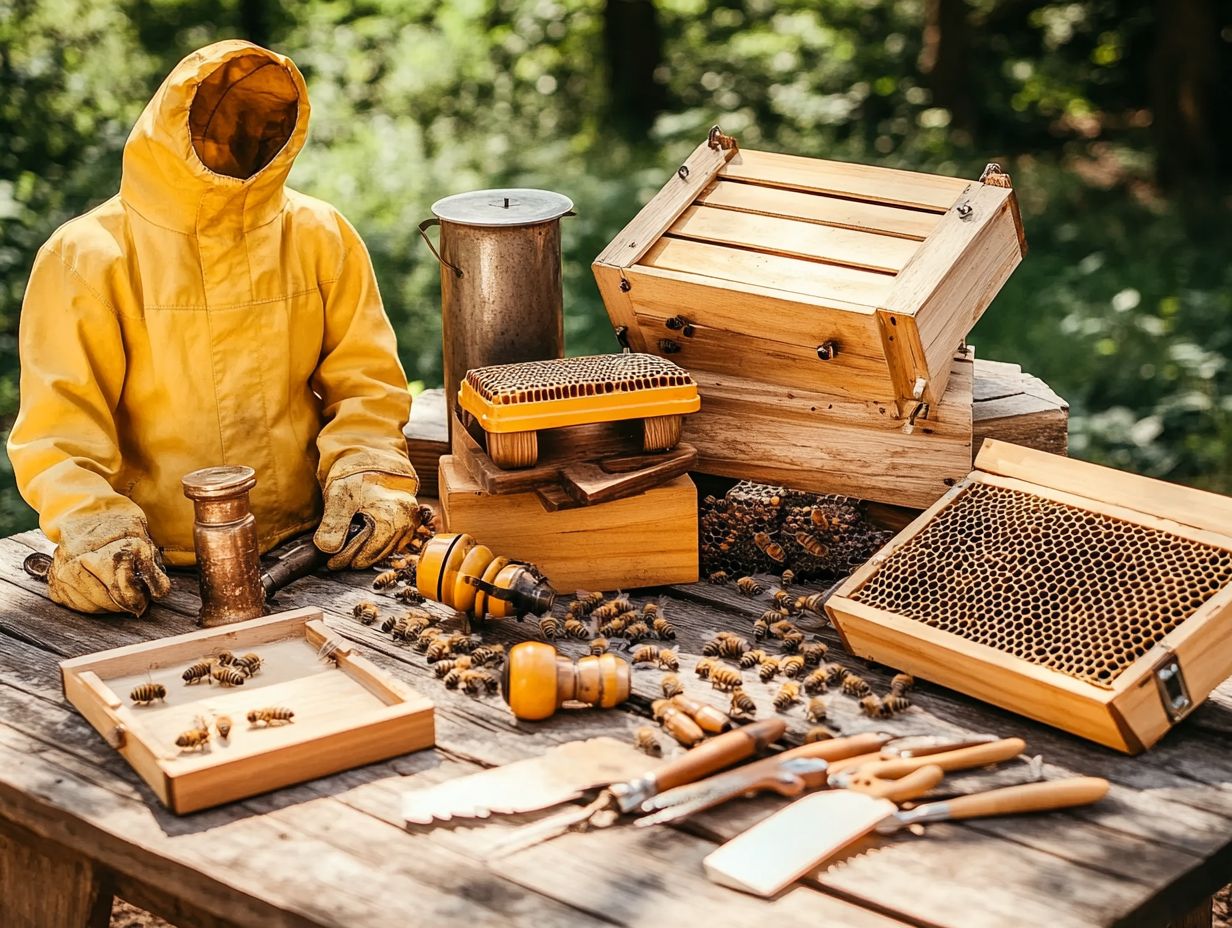
The top 5 beekeeping equipment for beginners are: a hive, protective gear, a smoker, a hive tool, and a bee brush.
2. Why is a hive considered the most important equipment for beekeeping?
A hive provides a safe and suitable environment for bees to live and produce honey. It also allows beekeepers to easily monitor and manage the beehive.
3. Do I need to wear protective gear while beekeeping?
Yes, wearing protective gear such as a bee suit, veil, and beekeeping gloves is crucial for beekeeping to prevent bee stings and potential allergic reactions. Beekeeping clothing, which includes a protective suit, is part of the essential beekeeping tools for ensuring safety.
4. How does a hive smoker help in beekeeping?
A hive smoker is used to calm bees by producing cool smoke, making it easier for beekeepers to work with the hive without causing agitation among the bees. This is a common practice in backyard beekeeping and is part of sustainable beekeeping techniques.
5. What is the purpose of a hive tool and other beekeeping tools in beekeeping?
A hive tool is used to scrape and pry apart beehives, making it easier to inspect and manipulate the beehive frames inside. Other essential beekeeping tools include a frame holder, bee brush, and hive inspection tools. Beekeeping starter kits often include these items.
6. Can a beginner start beekeeping without any beekeeping equipment?
No, it is not recommended for a beginner to start beekeeping without proper beekeeping equipment. Beginner beekeeping requires various supplies such as a bee hive, hive tool, smoker, and protective clothing. Beekeeping starter kits are available, which include many of these essential items. Proper equipment like honey bee feeders and ventilation tools ensures the safety and success of beekeeping operations.
Don t wait! Ensure your bees thrive by using the right equipment. Start your beekeeping journey today with the tools you need!

